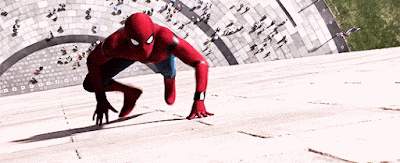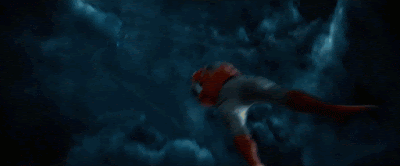or
"You Say that a Lot. What Are You Sorry For THIS Time? ("...Previously on 'Peter Screws the Pooch'")
At one point in Spider-Man: Homecoming, Peter—Spider-Man—Parker (Tom Holland) says to Tony—Iron Man—Stark (Robert Downey, Jr.) "I wanted to be just like you!" and Stark counters "...and I wanted you to be BETTER."
Precisely my feelings towards the Spider-Man 3.0 reboot, which I found a generally disappointing mess, with some very good things about it that did things differently...and refreshingly.
I like the fact that it doesn't take itself too seriously—the Tobey McGuire and Andrew Garfield versions had their moments of mirth, but got mired down in the soap opera aspects of the character and the weight of the "With Great Power Comes Great Responsibility" philosophy. This Spider-Man entry feels like a hyper-After-School Special that dispenses with the "Life with Archie" aspects of the traditional mythos ("Hmmm: Gwen or Mary Jane?") and features a cast far more diverse than merely blond and brunette. That's good. It plays around with the teen-hero aspect of Spidey—he's supposed to be 15 in the movie and Holland is 21 (McGuire started at age 27 and Garfield at age 29, the latter two abandoning High School for college) and sticks him in the very awkward high-school years of the character's origins in the early days of Spider-Man's history.
I like the fact that we don't have to go through the motions of seeing his origin story—bitten by a radio-active spider and suddenly finding himself with out-sized strength, sticky appendages, and the acrobatic skills and balanced of a headlining Cirque du Soleil performer. Here, Spider-man simply is. Doesn't matter how, and that he's young, eager, and learning is part and parcel of the origin, anyway. So, I'm glad we don't have to watch Krypton explode again...or his parent get shot in an alley...again. Let him be...in media res.
I like the fact that—like the recent Wonder Woman—there is no revenge plot. He's not trying to avenge the murder of his Uncle Ben (portrayed earlier by Cliff Robertson and Martin Sheen) or even girl-friend Gwen Stacy. He wants to be Spider-Man because being Spider-Man is cool! He also wants to be just like his hero Tony Stark—who has provided him with a too-gadgety Spider-Man suit (which gets very tiresome after awhile, more on that later).
But, the best part about it has little to do with Spider-Man or the new guy who's portraying him—it's the "villain." The best part of Spider-Man: Homecoming is Michael Keaton (former Bat-man, former "Bird-Man"). His Adrian Toomes aka "The Vulture" starts out as a blue-collar guy (actually he remains a blue-collar guy although he starts sporting a full collar later on—a neat touch) who's salvage company is in charge of cleaning up Stark Tower after the big dust-up The Avengers had with the Chitauri in downtown New York. "The world had changed," he opines to one of his grunts as they pick through the rubble, finding all sorts of neat other-worldly tech.
While he's ruminating on that and instructing his crew how they should use the alien gadgets to take other alien gadgets apart, they are interrupted by a police-escorted group from Stark Industries (including Tyne Daly!) telling them to cease and desist. Stark Industries has used their political clout to take over the salvage operation—Toomes and his crew are out of a job. "Times are changing," says Toomes as he pockets a couple items in secret. "We need to change, too."
It's curious. The focus of the Spider-Man movies should be Peter Parker, but here, with the puerile adventures of kid Parker and his High School buddies not providing anything of depth and his general dorkiness, you gravitate to Toomes, whose character is at least competent. He's not unbalanced, he's opportunistic, entrepreneurial, and he's got a well thought-out defense for doing everything he's doing. Yes, his "crew" is selling alien and extra-dimensional tech to criminals, but to hear Toomes tell it (to Parker), he's no different than Parker's hero, Tony Stark, who started out—and, for all intents and purposes, still is—an arms-dealer. But, Toomes sees a difference: "People like Stark—they're not like us—you and me. We build their roads, fight their wars, eat their table-scraps..." He thinks he's doing what he has to do to survive and to keep his family afloat and solvent. He's seen people go off the path and do well, and, for his family...why not?
Keaton is at the top of his game here. Laconic, thoughtful, dangerous, he has a lot of every-man bonhomie and you're drawn to him. But, the best scene in the film (which would be a crime if I spoiled by revealing it in any way) is his. And, it is played mostly silently with looks and deflecting casual dialog. Then, he delivers terms of engagement and he threatens our hero, his eyebrows arched, a smile on his face. What Keaton is doing is a bit reminiscent of what his co-star Jack Nicholson did playing The Joker opposite his Batman—there is a theatricality to it, but tamped down, malevolent but smoldering, and stated not as threat, but as fact. It's no wonder Tom Holland looks scared shit-less during the scene—Keaton is the villain and has stolen his movie.
So, that's the good parts: some good casting, some clever dialog here and there. Peter has an interesting story-arc—he begins wanting to be an Avenger like he was in Captain America: Civil War (Peter has done a selfie-video of his adventure in the other movie—from another studio) and realizes, eventually through the course of the movie, that he shouldn't be an Avenger, but can do the most good just by being "your friendly, neighborhood Spider-Man" (as the saying goes). And to have that arc, Spidey 3.0 has inserted itself into the tangled web of the Marvel Cinematic Universe, so, yes, there's a lot of the MCU poster-boy, Tony Stark—some of which is necessary (Toomes' motivation is squarely on the shoulders of Stark), but a lot of which is Robert Downey, Jr. collecting a pay-check. Chris Evans shows up in a running gag as Captain America keeps turning up in Public Service Announcements "for the kids"*
Here's the issue—it's all for a gag—it's tied to the Marvel movies, sure, but it also undercuts one of its major characters, doesn't respect him. I'm not sure what the internal logic of having Captain America be a role-model/spokes-hero "for the kids," since, after Civil War he's now considered an "outlaw" in the Marvel movies. But, hey, it's for a gag and another tie-in to the popular movies, right, so what's the harm? That it makes no sense probably shouldn't matter, as it's a "Spider-Man" movie, which should be it's own "thing," a Universe in a bottle...but for marketing purposes—to make sure there aren't any entries like the third Tobey McGuire and the second Andrew Garfield movies that have a slight down-tick in revenues to make studio executives nervous—they bring in popular characters from other Marvel movies...and...diminish them. Curious strategy, that.
Also, the presence of Stark contributes to something I find just annoying, but it's annoying for a significant amount of running time in the film: Spidey's suit. Looks good, okay. But, over the course of the movie, you find that there are so many goo-gah's and other gizmo's in it that you could imagine that given a good remote control, you don't even need a person in it.** The eye-holes respond to emotions (a trait picked up from Deadpool) and the mask has a "heads-up display" like Iron Man, they can control the types of webs he shoots, and, most egregiously, he has a "Siri" voice in his suit (voiced by Jennifer Connelly), who gives him so much information that there is no need for him to think. But, it does give him plenty of time to talk, which he does incessantly while he's trapped overnight in a weapons warehouse. Guess it beats trying to find an exit somewhere.
 |
| Need a lot less of this. |
But, the thing that really disappointed me is a problem that past Spider-Man films have had—a needlessly frenetic pace and editing by a cuisinart. It's happened in Spider-Man 3 and The Amazing Spider-Man 2 (the ones fewer people saw and caused the respective re-boots). The timing is off on a few things because there seems to be an attempt to shoe-horn as many bits of business and details as possible, but not to dwell on them (one isn't given enough time to notice them!). Look at that fight gif above. See how things don't seem very smooth and jerk around a bit. That's because the director—or it could be 2nd, even 3rd unit-director—didn't have a basic design strategy that would make the fight work as a whole, followable sequence. They basically took bits and pieces, added some inserts and just thought it would come out looking good in the editing room. It didn't, and it doesn't.
 |
| "See? Superman isn't the only hero who's a Christ-allegory!" |
So, there's less doom-and-gloom and Spider-moping in this Spider-Man movie. But, I can't say things have noticeably improved. In fact, the character seems even less important in his own series than when he started to be crowded out by villains. Maybe someday there will be another good one along the lines of Spider-Man 2—still one of the best movies in the super-hero genre—but this one isn't it. This third time has some charm, but it's not enough to keep it off the bargain racks at your friendly neighborhood supermarket.
* The punch-line of which is Cap showing up in the completely superfluous Final Credits Teaser that completely nerd-bashes the idea of sitting through the Credits to watch to the teaser: "Hi, I'm Captain America. Here to talk to you about one of the most valuable traits a student or soldier can have. Patience. Sometimes, patience is the key to victory. Sometimes, it leads to very little, and it seems like it's not worth it, and you wonder why you waited so long for something so disappointing... How many more of these?"
** There's an antecedent in the comics for this: Spider-man has an enemy named "Venom"—he was briefly in Spider-Man 3 (the only #3 there has been), which is essentially a Spider-Man costume that possesses people (yeah, don't even ask, True Believer...)














No comments:
Post a Comment